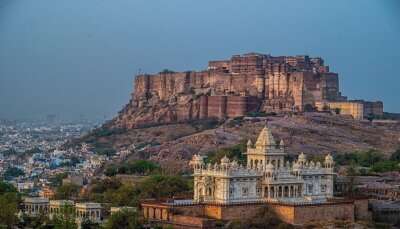Guide To The Forgotten Monument Of Ahar Cenotaphs In Udaipur
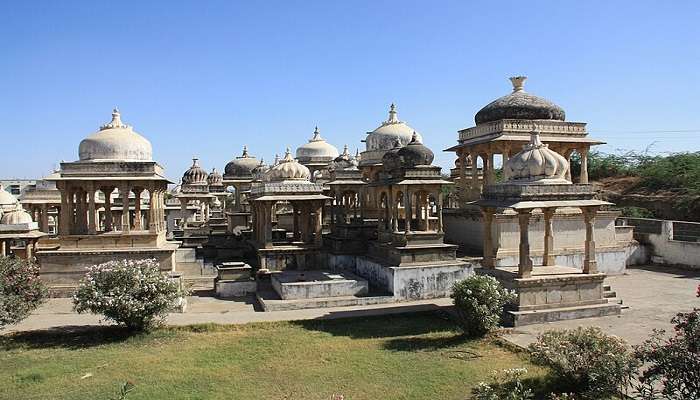
Ahar Cenotaphs in Udaipur are a group of cenotaphs located in Ahar, Udaipur. More than 250 cenotaphs honouring the Maharanas of Mewar, which date back about 350 years, can be found at the location. Also present on site to honour the 19 maharajas who were cremated here, there are 19 chhatris. Chhatris are elevated, domed pavilions which is a prominent feature of Indo-Islamic architecture. This collection of royal memorials stands as a testament to the rich history and architectural grandeur of the Mewar dynasty. These cenotaphs, serve as commemorative monuments for the maharajas and queens of Mewar, encapsulating the legacy of one of India’s oldest and most illustrious dynasties.
About The Ahar Cenotaphs In Udaipur
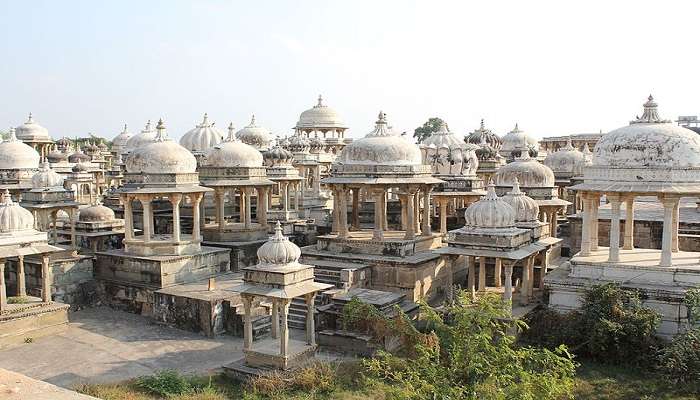
With traces of human habitation stretching back over 4,000 years to the Chalcolithic era, the town of Ahar has been a significant archaeological site for a long time. The majority of the noteworthy structures were built between the 15th and 19th centuries. However, the cenotaphs themselves are rather old as they belong to the 10th century, according to modern carbon dating methods. As the royal burial place of the Mewar monarchs, starting with Maharana Amar Singh I in 1620, the location garnered popularity and with the construction of more than 250 cenotaphs since then, Ahar has become an important historical and cultural monument in Rajasthan. The last cenotaph was constructed for the cremation of Maharana Bhagwat Singh in 2004.
In the 1990s, an initiative to restore the legacy of the ancestors of the Mewar dynasty was started by Arvind Singh Mewar, one of the few descendants of the Mewar Dynasty. He implemented plans to restore its former splendour. During this procedure, he obtained the construction of a museum at the current Ahar Archaeological Museum complex. A plethora of rare Tenth-century artefacts relating to the Mewar Dynasty may be found at the Ahar Archaeological Museum. In recent years, efforts have been made to preserve and promote the Ahar Cenotaphs as a tourist destination. The Archaeological Survey of India (ASI) and local authorities have taken steps to maintain the site and provide facilities for visitors. Tourists visiting Ahar can explore the serene and majestic cenotaphs, gaining an appreciation for the artistry and historical importance of these monuments. The site is also a popular spot for photographers and history enthusiasts.
Must Read: Taj Lake Palace Udaipur
Architecture Of Ahar Cenotaphs
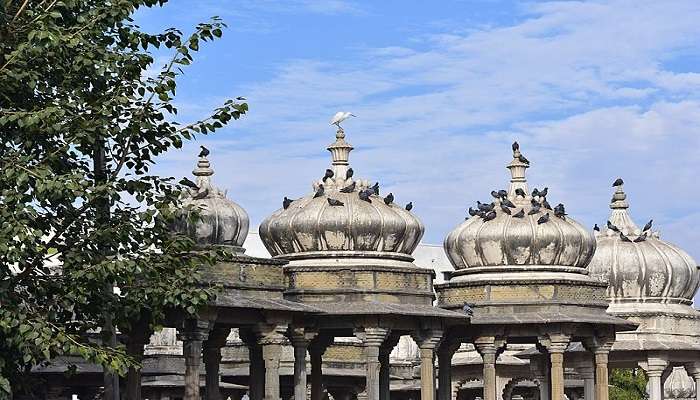
The Ahar Cenotaphs are a remarkable example of Rajasthani architecture, characterised by elaborate designs and intricate carvings. These cenotaphs are primarily built in marble and are adorned with beautiful carvings, frescoes, and detailed masonry work. The courage and splendour of the legendary Mewar Empire rulers are exalted in the architecture of the Ahar Cenotaphs. To honour the brave rulers, people travel to these locations. The cenotaph area of Ahar homes has the cremated remains of around 19 rulers. This area is even more beautiful because of the memorial’s remarkable architecture. The beautiful columns on upper platforms are tastefully shaded by arched roofs, adding to their overall attractiveness. The Ahar Cenotaphs have tastefully placed studded ceilings. The magnificent temples constructed in the middle of the fifteenth century served as inspiration for the same.
The primary architectural feature of the cenotaphs is the chhatri, or dome-shaped pavilion, which is supported by intricately carved pillars. These chhatris often have multiple levels and are decorated with motifs of gods, goddesses, and other symbolic figures. In addition to being architectural wonders, the Ahar Cenotaphs provide insight into the Mewar dynasty’s rich cultural and historical past. They shed light on the royal family’s habits and traditions, especially the one of honouring the deceased with imposing monuments. With its use spanning several centuries, the cenotaphs further emphasise the significance of Ahar as a holy shrine for the Mewar royal family. For historians and archaeologists researching the history of the area, the existence of inscriptions and intricate carvings provides invaluable information.
Places To Visit In And Around The Ahar Cenotaphs
Udaipur is a scenic place with lots of historically significant places, and The Ahar Cenotaphs is one of the famous monuments. Here is the list of places to visit in and around the Ahar Cenotaphs:
1. The City Palace
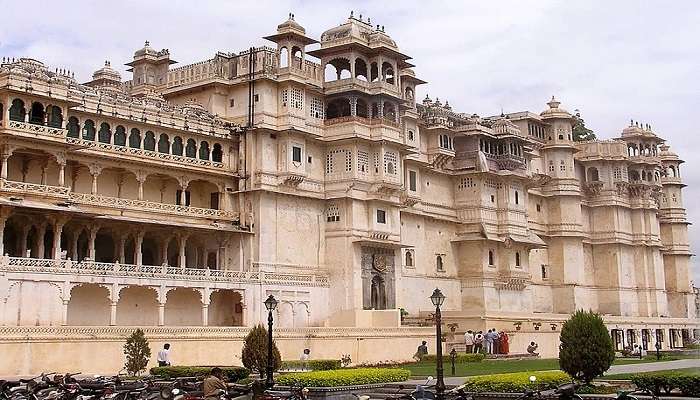
Udaipur is home to the royal complex known as City Palace. Several Mewar dynasty monarchs provided support during its 400-year construction. Work on the building started when Maharana Udai Singh II of the Sisodia Rajput family relocated their capital from the old Chittor to the recently established city of Udaipur in 1553. The palace complex is located on the eastern edge of Lake Pichola and houses many palaces within its gates. The flamboyantly constructed City Palace in Udaipur is thought to be the biggest of its kind in Rajasthan. With a blend of Rajasthani Rajput and modern style, it was constructed on a hill to offer a sweeping view of the city and its surroundings.
Suggested Read: Things To Do In Udaipur
2. Jagdish Temple
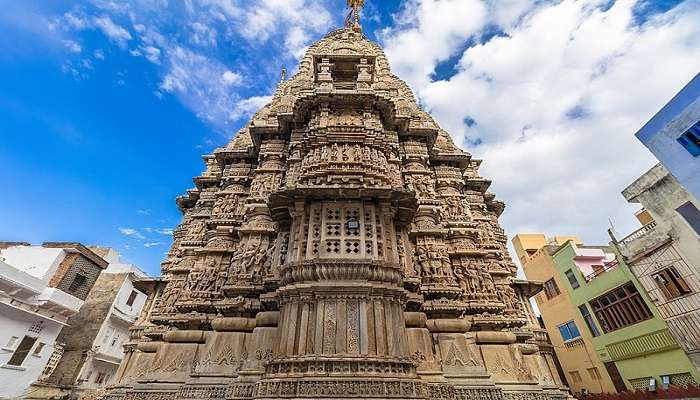
Located directly outside the royal palace in the heart of Udaipur is the sizable Hindu temple known as Jagdish Temple. It has been continuously adored since 1651. Jagdish-ji, once the temple of Jagannath Rai, is today’s well-liked tourist attraction. Situated on a tall terrace, the Jagdish Temple was finished in 1651. It links a two-story covered passageway sanctuary to a two-story Mandapa hall. Beneath the pyramidal bell dome of the mandapa is another level, and in the hollow clustered spire above the sanctuary are two further non-working floors. A brass statue of Garuda, the deity Vishnu’s steed known as Vahana, blocks the top of the 32 marble stairs that lead to the main shrine.
3. Sahelion Ki Bari
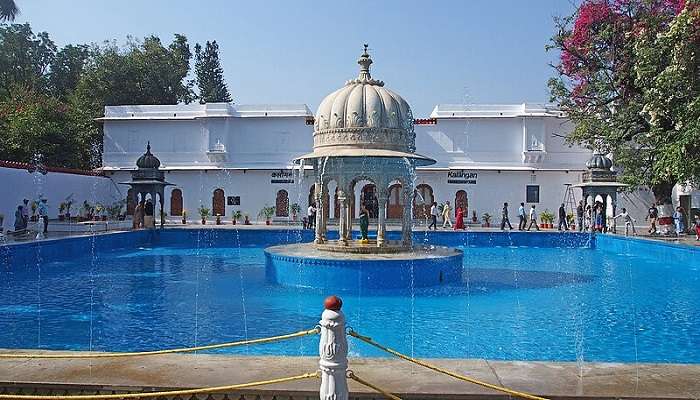
In the Rajasthani state of Udaipur, the Courtyard of Maiden, also known as Sahelion Ki Bari, is a significant and well-liked garden and tourist destination. The builder of it was Maharana Sangram Singh. On the grounds, there is a museum complex as well. According to legend, a group of 48 young ladies known as Sahelion ki bari were given as dowry to the princess of Udaipur. That’s why this garden was made for them. The park has exquisite lotus ponds, flowers, distinctive elephant-shaped fountains, and marble pavilions. Between 1710 and 1734 AD, Maharana Sanga Singh constructed this garden for the royal women, which is located close to Fatehsagar Lake. However, some evidence suggests that Maharana Sanga created this garden and gave it to his queen.
Suggested Read: Udaipur Travel Tips
4Jag Mandir Palace
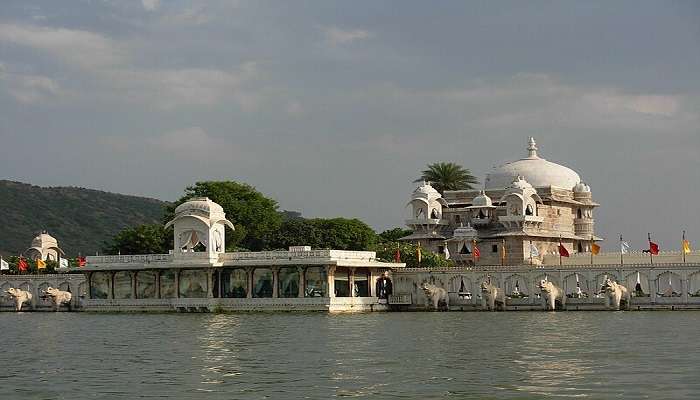
Situated on an island in Lake Pichola, the Jag Mandir palace is often called the “Lake Garden Palace”. It is said to have been constructed by three Maharanas of the Sisodia Rajputs of the Mewar dynasty. In 1551, Maharana Amar Singh started construction on the palace. Maharana Jagat Singh I completed the structure, which Maharana Karan Singh had started. It is known as Jagat Mandir in honour of the late Maharana Jagat Singh. The royal family used the palace as a summer getaway and a gathering place. The palace served as a haven for those seeking asylum at one point.
Further Read: Delhi to Udaipur Road Trip
The Ahar Cenotaphs in Udaipur stand as a testament to the enduring legacy of the Mewar dynasty. These monuments, with their intricate designs and historical significance, offer a glimpse into Rajasthan’s royal past. So, do keep these facts and places in mind when planning your trip to Udaipur.
For our editorial codes of conduct and copyright disclaimer, please click here.
Cover Image Credit: Jstplace for wikimedia commons.
Frequently Asked Questions About Ahar Cenotaphs In Udaipur
What is Ahar Cenotaph?
Ahar Cenotaph is a memorial/burial site dedicated to all the kings and descendants of the Mewar dynasty of Rajasthan.
Where is Ahar Cenotaph located?
Ahar Cenotaph is exactly 1.3 km from Udaipur city centre. Which is a 5-minute drive by car or a 10-minute walk.
Who was the last person to be cremated at Ahar Cenotaph?
The last cenotaph at Ahar Cenotaph was constructed for the cremation of Maharana Bhagwat Singh in 2004. Since then, there have been no cremations at the site.
How long will it take to explore the Ahar Cenotaph?
It will take around 2 hours to fully explore the premises, but it might take longer depending on how well you want to document the site.
How far has the Ahar Cenotaph from Bangalore?
The Ahar Cenotaph is located around 1600 Km away from Bangalore, which is a 30-hour drive, so it is advised to make this trip by train or flight.
People Also Read:
Adventure Sports In Udaipur Places To Visit In Udaipur Resorts In Udaipur

With a passion for exploring and travelling to the roads long forgotten, experience the world through enthralling stories and adventures. Join me as I share my experiences at some of the world’s most popular tourist destinations and quench that pestering curiosity with something exciting!




